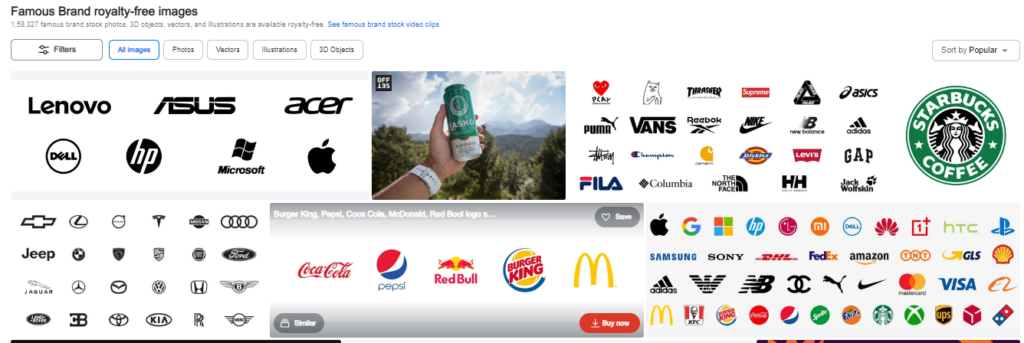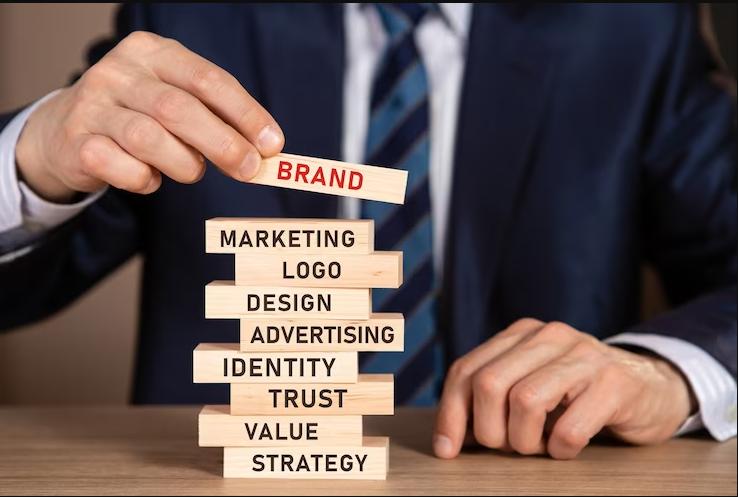Imagine you’re strolling down a supermarket aisle, searching for a refreshing beverage. Among the myriad options, your eyes land on a familiar red and white label—Coca-Cola. Without a second thought, you reach out and grab it.
Let’s imagine another situation: you’re driving around a new town or city. It’s noon, hunger strikes, and you’re scanning for a place to eat. While numerous eateries line the street, none stand out to you. But then you spot the Golden Arches—McDonald’s. Voilà! Without hesitation, you steer into the parking lot.
This instantaneous recognition and trust in a product or a brand is the essence of brand awareness. It refers to the extent to which people are familiar with the distinctive qualities of a particular brand. It’s not just about recognizing a name or a logo; it’s about the emotions, memories, and associations that come to mind when someone thinks of a brand.
Why is branding critical for business?
First and foremost, branding paves the way for loyalty. When customers are aware of a brand and have positive associations with it, they’re more likely to choose it over competitors. This not only creates recurring business but also prompts customers to recommend the brand to others, effectively serving as brand ambassadors. After all, before a consumer can purchase a product or service, they first need to know it exists!
In today’s bustling online marketplace, countless businesses vie for the same customer attention. The way you can differentiate, create the best impression at first sight, and establish a loyal customer base is through brand awareness.
The Power of Branded Websites
Since this topic is about websites, let’s look at why branding starts with a website. A website is the key asset as it acts as the digital face and front door of a business, often having the initial interaction with potential customers. Hence, a website is the best place for crafting that vital first impression and fostering a sense of familiarity.
According to Salesforce, generating a viable lead requires 6 to 8 touches. This suggests that a visitor must remain engaged with and considerate of your brand over an extended period before responding to your call to action. A website that clearly communicates its branding exudes professionalism and authenticity. Such a a a a website is more likely to remain in a visitor’s memory, which in turn increases the chances of return visits and the likelihood of the visitor taking the desired action. It also makes you purchase or share contact details.
Website Branding Elements
When it comes to branding, everything from the design, content, and overall feel should resonate with your brand. Core branding elements, such as logos, color palettes, typography, and imagery, play crucial roles. For instance, the logo often anchors the brand’s identity, while a consistent color palette reinforces brand recognition. Typography and content voice reflect the brand’s character, and curated imagery underscores its values and messaging. Below are some of the branding elements to think about when setting up your website
Logos
The image speaks volumes. A logo is a brand’s visual cue; it’s a concise representation of a company’s identity, values, and promise. When designing a professional logo, ensure that it’s memorable, scalable (looks good both big and small), and relevant to the business offerings. Simplicity often reigns supreme; the most iconic logos are typically straightforward yet impactful.


As for the placement of a logo on a website, the top left corner has become the industry standard, largely because people in many cultures read from left to right, starting from the top. By placing the logo there, businesses align with natural viewing patterns, ensuring quick recognition. Additionally, it’s common practice for the logo to be clickable, leading back to the homepage. This not only aids navigation but also reinforces brand identity throughout the user’s site experience.
Color Scheme
While you’re browsing the internet, you may notice a huge spectrum of colorful websites. The colors aren’t just for aesthetics; they carry psychological weight, shaping our perceptions and influencing our decisions.
A color scheme sets the visual tone for a website. Each hue communicates distinct emotions and messages. For instance, blue often signifies trust and calmness, making it a favorite for financial and tech businesses. Green resonates with eco-conscious customers, while luxury brands lean towards black to convey sophistication and exclusivity.
Colors also influence purchasing behaviors. Research has shown that color can affect users’ perceptions of a brand and, consequently, their willingness to trust and buy from that brand. For example, Red, being an intense color, can evoke feelings of passion and urgency; hence, it is often used for call-to-action buttons like offers, sign-ups, or making a purchase
If you are looking for a brand color, choose a color scheme that aligns with your target audience. It’s about striking a balance between a personal brand message and the universal language of colors. So, when selecting a palette for your site, delve into the emotions and responses each color elicits, ensuring they mirror your brand’s intent and cater to your audience.
Typography
Typography, in essence, is the art of arranging text in a legible and appealing manner. It’s not just about selecting a font but also about setting the tone and personality of your brand’s voice. The nuances in typography—from font choice, weight, spacing, and style—all converge to tell a visual story.
Let’s take a glance at some iconic brands. Apple, for instance, uses the sleek San Francisco font, exuding simplicity and modernity. Coca-Cola’s custom, flowing script is as recognizable as its logo, evoking nostalgia and warmth. Nike’s bold, uppercase typeface mirrors its message of determination and strength.
When choosing typography for a website, there are a few key considerations. Readability should be at the forefront; if your audience struggles to decipher the text, the message is lost. Consistency is crucial; sticking to a select few fonts ensures a cohesive look. Whether it’s a clean sans-serif for a tech startup or an elegant serif for a luxury boutique, the right typography must amplify a brand’s voice.
Images & Graphics
Ever clicked on a website and been instantly captivated by a breathtaking image? That’s the magnetic pull of visuals in the digital landscape. In the blink of an eye, they convey emotions, set expectations, and communicate messages, often more effectively than blocks of text.

Images and graphics bring life to a site, providing context, enriching content, and enhancing user engagement. High-resolution images are a must. The clarity of a high-resolution image ensures the brand appears top-notch and fosters trust among visitors.
If you’re brand conscious, using quality, original visuals, and photographs can set your brand apart from competitors relying on generic stock images. Original visuals, whether product shots or behind-the-scenes glimpses, add authenticity and depth to a brand’s narrative.
Graphics, on the other hand, including illustrations and icons, can simplify complex ideas, guide users, and inject creativity into a site. Their consistent style and color palette further solidify brand identity.
When curating images and graphics for a website, prioritize quality, relevance, and authenticity. These visuals are the silent ambassadors of your brand. Ensure they speak volumes, resonate with your audience, and, above all, genuinely represent your brand’s essence.
Voice & Tone
Voice is the consistent, overarching persona of a brand—its character. It remains constant and reflects the brand’s values, mission, and identity. Whether it’s confident, playful, authoritative, or compassionate, voice sets the stage for all brand communications.
Tone is the fluctuating mood or emotional inflection applied to the voice based on the situation.
While a brand’s voice might be upbeat, its tone might shift from celebratory in an anniversary post to empathetic in a crisis response. For example, Mailchimp, the email marketing platform, is renowned for its friendly and quirky voice. Even in instructional content, the brand manages to sound approachable and lighthearted.
For businesses crafting website content, understanding and implementing the right voice and tone is important. It’s not just about what you say, but how you say it. Ensure the voice of the content reflects your core attributes and values. Then adopt the tone based on the context, always keeping your customer’s feelings and expectations in mind.
In summary, voice and tone, when harnessed correctly, build trust, set expectations, and form deep connections with the audience.
Brand Messaging
Imagine walking into a party and introducing yourself. How you speak, the words you choose, and the tone you adopt tell others about who you are. Brand messaging on a website service that plays an exact role for a business

Brand messaging is the way you communicate your brand in words, shaping perceptions and setting expectations. It’s the narrative that weaves its way throughout your entire site, telling visitors not just what you do but why you do it and why it matters to them.
Think about Nike’s core message, “Just Do It” – an empowerment manifesto urging people to overcome obstacles and achieve their goals. Or take Dove’s “Real Beauty” campaign, which dives deep into promoting self-confidence and challenging beauty standards. These brand messages resonate because they’re not just about selling products; they’re about conveying values and evoking emotions.
When crafting your brand messaging:
- Be authentic. Your message should align with your brand’s mission and vision.
- Speak to Your Audience: Understand their needs, desires, and pain points. Address these in your messaging.
- Keep It Consistent: From your home page to your product descriptions, consistency reinforces brand recognition and trust.
- Make It Memorable: Your message should stick. Whether it’s through wit, emotion, or a unique value proposition, strive for a message that lingers long after the browser window closes.
Brand messaging, when done right, doesn’t just describe what you offer; it encapsulates why that matters, turning casual browsers into loyal customers.
Tagline of Home Page Title
A tagline or main header title on a website’s home page is more than just a catchy phrase; it’s the brand’s core value condensed into a few words. It gives visitors immediate clarity about the brand’s mission, vision, or value proposition.
Take Nike’s iconic “Just Do It” or Apple’s “Think Different.” Disneyland’s “The Happiest Place on Earth” is not just a statement; it’s a promise of joy and nostalgia. Similarly, M&M’s “Melts in Your Mouth, Not in Your Hands” speaks directly to the product’s unique value proposition. These taglines create an immediate emotional connection with the audience.
For websites, the header title is where you can highlight your brand purpose. Consider Airbnb’s home page header, “Belong Anywhere.” In just two words, they encapsulate the essence of their service: offering unique, homely experiences for travelers worldwide. Likewise, Slack’s “Made for People, Built for Productivity” directly addresses the platform’s purpose while subtly hinting at its ubiquity in the professional world.
Crafting the perfect tagline or main header for your brand requires deep thinking. When brainstorming, consider your unique selling points, the target audience’s aspirations, and the emotions you aim to evoke. It should resonate with your core values while also appealing to the target audience’s desires or needs. It’s about striking a balance between being catchy and genuine.
Navigation & Layout
At the heart of an effective branded website lies intuitive navigation. It’s about ensuring that visitors can quickly locate information, products, or services without hassle. A popular navigation approach is the “three-click rule,” suggesting that users should access any information in just three clicks. Top-tier brands often employ clean, top-horizontal menus or hamburger menus for mobile, making site exploration a breeze. Apple, for instance, utilizes a minimalist top-horizontal menu, grouping products and services cleanly and allowing users to dive deep without feeling lost.
Layout, on the other hand, pertains to the organization and presentation of content. A cluttered, overwhelming layout can deter visitors, while a clean, structured layout can enhance engagement. Grid layouts, like the one used by Airbnb, are a popular layout, presenting key information in the top fold and leading the eye naturally down the page.
Responsive Design
Responsive design ensures your website looks and functions seamlessly across various devices, from desktops to smartphones and tablets. In a world where a significant chunk of users access the internet via mobile, a responsive design is a necessary feature. It guarantees a consistent, user-friendly experience, irrespective of screen size. Below are some of the key considerations when designing a responsive website.
- Fluid Grids: Use percentages instead of fixed pixels for layout elements, ensuring that the content resizes proportionally based on the screen size.
- Flexible Images: Images resize within their containing elements, so they don’t spill off-screen or look too tiny.
- Media Queries: These are essential bits of CSS magic that allow websites to apply different styles based on the device’s characteristics, like its width or height.
Responsive design not only enhances the user experience, but it can also boost SEO, as most search engines, like Google, favor mobile-friendly websites in search results.
Call-to-Actions
A call-to-action is essentially your website’s directive to the visitor, steering them towards the next desired step. It is the bridge between user interest and user action. Whether it’s making a purchase, subscribing to a service, or simply learning more about a product, a clear CTA guides the user’s journey.
Some common CTAs include:
- “Shop Now” directs users straight to the purchase phase. For instance, many e-commerce brands, like Adidas or Shopify stores, prominently display this to boost sales.
- “Learn More“: Used by businesses, like Apple, when introducing a new product. It invites users to delve deeper into the specifics.
- “Sign Up” or “Subscribe”: Often used by platforms like Netflix or SaaS businesses, prompting users to join or receive regular updates.
- “Get Started“: A favorite of services like Dropbox or Canva, encouraging users to begin their experience.
When integrating CTAs, ensure they are appropriate to the context and feel organic within the content. Use the language that is inviting and position it in the top fold. CTAs buried at the bottom might get overlooked, and using them too often or too early might seem pushy. Therefore, as you design or refine your website, remember: your CTAs are where the magic happens. Craft them with care and clarity.
Summary
Branding is the heart and soul of any business, defining its identity, values, and promise to customers. It’s the story you tell, the perception you create, and the mark you leave. From the empowering message of Nike’s “Just Do It” to the embrace of real beauty by Dove, effective branding resonates, motivates, and lingers in consumers’ minds.
When we talk about website branding, we’re extending this core identity into the digital space. A website is often the first interaction a potential customer has with a brand. From its logo, color theme, and typography to the tone of voice, images, and layout—all elements must harmonize to project the brand’s essence consistently.
Given that there are many nuances in creating a distinct brand of website, But with the right guidance, tools, and expertise, your brand can shine online just as it is offline. Ready to set up your brand online? Check out Minutly services that can help you get started on the right path.








How to launch your web application development service
Website with a purpose: How to drive quality website traffic?
How to start a Generative AI Service: A Comprehensive Guide (2024)
How to launch your web design service – A comprehensive guide to success
What is a Service Catalog?
Top 10 Essential Sales Service Requests Every Business Should Offer
Sharing your Minutly Catalog
Setting up your catalog